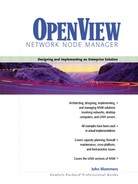Accessing NNM Remotely
How can a member of the network support staff who is armed with a laptop computer at a remote location (say, at home or in a hotel room) access one of the corporate NNM systems to work on a problem?
A simple, low-performance solution is to connect a modem port on the NNM system to a prearranged telephone line. The remote staff member dials this number and logs into the UNIX system by supplying their account name, account password, and the dial-up password. A terminal session is initially established, limiting the available toolset to command line applications. However, a point-to-point protocol (PPP) connection can be configured either manually or at login time to allow the laptop to work as a remote network node. The troubleshooter can now run an X-Windows emulator to gain access to the full NNM GUI. Bandwidth limitations of dial-up modem connections will seriously reduce the responsiveness of the X-Windows applications. VNC (virtual network computing) is a good dial-up access solution, as it uses far less bandwidth than X-Windows.
Most corporations provide a more secure and potentially higher performance solution for remote laptop users in the form of dial-up “1-800” access requiring SecureID cards for authentication. The laptop computer becomes a trusted node on the corporate network and the remote network troubleshooter gains access to the NNM system via telnet or X-Windows. Of course, if access to the NNM system is blocked by the network outage, the direct dial-up modem solution is the backup solution.
Remote workers at fixed locations such as their homes are often provided secure access to the corporate network using the speedier 128Kbps ISDN service. ISDN is secure due to automatic number identification (ANI) inherent in the signaling system 7 (SS7) protocol used by ISDN.
Remote users working at home may also enjoy high-speed Internet access in the form of digital subscriber loop (DSL), cable modem, or fiber to the home (FTTH) service. Here, some corporations have opted to use virtual private network (VPN) technology to create a secure, encrypted IP tunnel between their home computer and the corporate network. This provides a workable, high-speed method of accessing the corporation’s NNM systems remotely. Again, it’s assumed that the network outage does not affect access to the NNM system.
